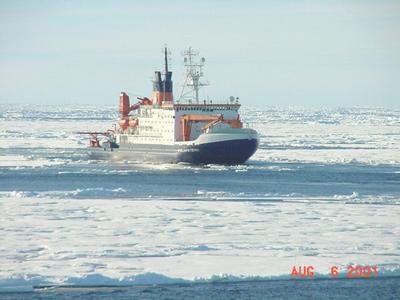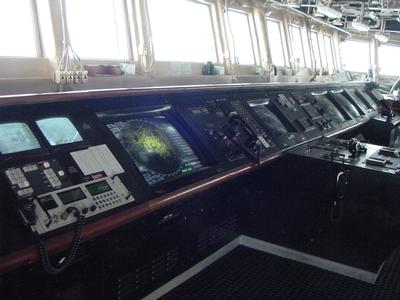28 August, 2001
August 28, 2001
A Neighborly Rescue
Yesterday afternoon the Healy and the Polarstern were heading along Gakkel
Ridge collecting data for maps. Several hours after our travels began a
scientist who was monitoring our track noticed that the Healy was making a
circle. This seemed strange because we were to be leading a path through
the ice for the German icebreaker to follow. It was then that I learned
that the Polarstern was stuck!
The Polarstern was traveling behind us in the channel we had created in the
ice. Due to the drift, the channel was closing up quickly, so the
Polarstern tried to stay close behind. However, a point came where our
neighbors were squeezed in between the ice and brought to a stop. After a
half dozen or more attempts at ramming their way out, the Polarstern needed
our help. Even their 4 engines couldn't free them! So the Healy circled
around, passed within 100 yards or so of our grounded companions, and broke
the floe for them. They were free!
This example shows why it is smart to have two icebreakers involved in
traveling to a remote region such as this. If you are familiar with past
polar exploration, you know that many people died in areas such as the one
we are now in. Imagine exploring Gakkel Ridge 100 years ago in a wooden
ship with no electricity or comforts of home (like movies, a gym, and a
coffee shop). Imagine no modern fabrics (like fleece or Gortex) for keeping
warm. Imagine no computers for navigation or communication. It took a very
brave and adventurous soul to take part in polar travel.
Today's technology has enabled us to travel more comfortably, safely, and
easily, than ever before-- but Mother Nature hasn't changed. So it's always
best to be prepared for problems that you may encounter. And if you need a
little help-well, that's what neighbors are for.

The Polarstern follows the Healy. Here it is having no problems making its way through the ice. <>

The technology on the "bridge" allows the crew to monitor almost everything. The screen near the left with yellow splotches is a radar of the ice coverage. This information is especially helpful in foggy weather. <>
Contact the TEA in the field at
.
If you cannot connect through your browser, copy the
TEA's e-mail address in the "To:" line of
your favorite e-mail package.
|
